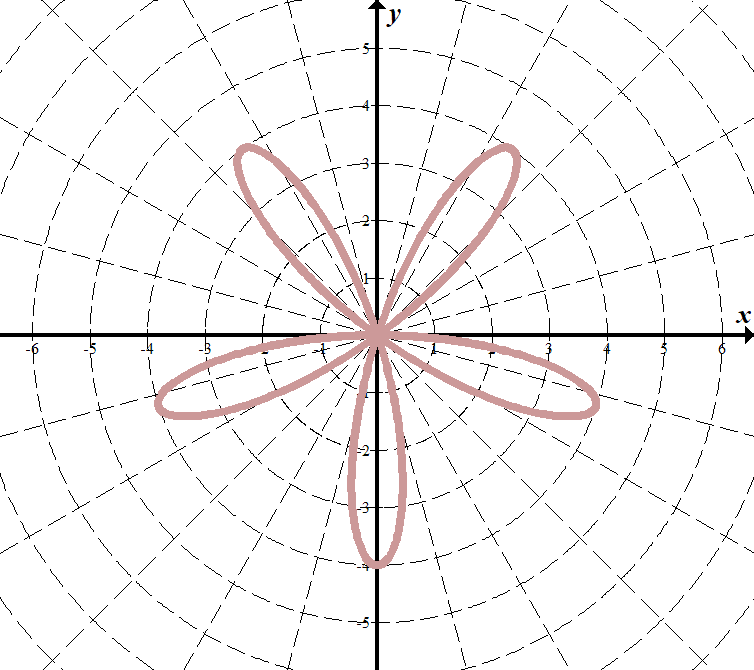What is the axis of symmetry of this polar equation?
r = 3cosθ
The polar axis.
What is the domain of the graph?
x(t) = 3t+1
y(t) = t^2
-1≤t≤3
-2≤x≤10
Convert the set of polar coordinates to rectangular coordinates.
(3 , - π/3)
(3/2 , -3√3/2)
or
(1.5 , -2.598)
What is the powerhouse of the cell?
The Mitochondria is the powerhouse of the cell.
What are the coordinates of the set parametric equations when t=0?
x = 4-2t
y = 3 + 6t -4t2
(4 , 3)
What is the shape of this graph?
r = 2±3cosθ
A limaçon.
Write this parametric in rectangular form.
note: square root sign covers the entire expression on the right side.
x(t) = √ (2t+1)
y(t) = t/4 + 2
( x^2 + 15 ) / 8 = y
or any other variant of that.
Whats are the polar coordinates of these rectangular coordinates?
(0 , 2)
(2 , π/2)
What AP course does Mr. Gordon teach?
AP Biology
Convert the set of parametric equations to rectangular form.
x = t - 5
y= t2
y = (x + 5)2
or any other variation.
How many petals are on the graph of this polar equation?
r = 10sin4θ
8 Petals.
What is the shape of the given set of parametric equations?
x = 7cos(t)
t = 10sin(t)
An ellipse.
Convert the set of rectangular coordinates to polar coordinates. Answer in degrees.
( 3, √3 )
(2√3 , 30°)
Which element is most electronegative?
Fluorine.
Free 300 Points!
N/A
What are the zeroes of this polar equation?
r = 1+2sinθ
7pi / 6
11pi / 6
What is the max |r| value and at what angle(s) will the graph reach the max r value of the following equation?
Give angles in radians.
r = 1+2cosθ
The max |r| value is 3, at angle 0.
Find another polar coordinate between 0 and 2 pi that describes the same point as (3 , pi/6).
(-3, 7pi/6)
Who made this jeopardy? You only need to know answer one correct name.
Hints: At the time of this making, two of them were sophomores, one is a junior.
One plays volleyball and basketball.
The other two play tennis.
Jaden Mak
Kevin Lee
Sam Chen
Convert the following parametric equation to rectangular form.
x = -4 + 2cost
y= 3 + 3sint
((x+4)2 / 4) + ((y-3)2/9) = 1
or a variation of it.
Graph this polar equation.
r = -4sin5θ.

Graph this set of parametric equations with a properly labelled direction.
y=2sin(t)
x=1+cos(t)
Open the above link for image of graph. The direction is counter-clockwise.
https://graphsketch.com/parametric?mode=para&eqn1_color=1&eqn1_x=1%2Bcos(t)&eqn1_y=2sin(t)&eqn2_color=2&eqn2_x=&eqn2_y=&eqn3_color=3&eqn3_x=&eqn3_y=&x_min=-17&x_max=17&y_min=-10.5&y_max=10.5&t_min=-10&t_max=10&x_tick=1&y_tick=1&x_label_freq=5&y_label_freq=5&do_grid=0&do_grid=1&bold_labeled_lines=0&bold_labeled_lines=1&line_width=4&image_w=850&image_h=525
Convert the polar coordinates to rectangular coordinates.
(3√2 , 5pi/4).
(-3 , -3)
What is 0 to the 0th power?
1.
Graph this set of parametric equations.
x = -2sin(t)
y = -7cos(t)
The equation should have a clockwise rotation.
The link to the graph is below.
https://graphsketch.com/parametric?mode=para&eqn1_color=1&eqn1_x=-2sin(t)%20&eqn1_y=-7cos(t)&eqn2_color=2&eqn2_x=&eqn2_y=&eqn3_color=3&eqn3_x=&eqn3_y=&x_min=-17&x_max=17&y_min=-10.5&y_max=10.5&t_min=-10&t_max=10&x_tick=1&y_tick=1&x_label_freq=5&y_label_freq=5&do_grid=0&do_grid=1&bold_labeled_lines=0&bold_labeled_lines=1&line_width=4&image_w=850&image_h=525